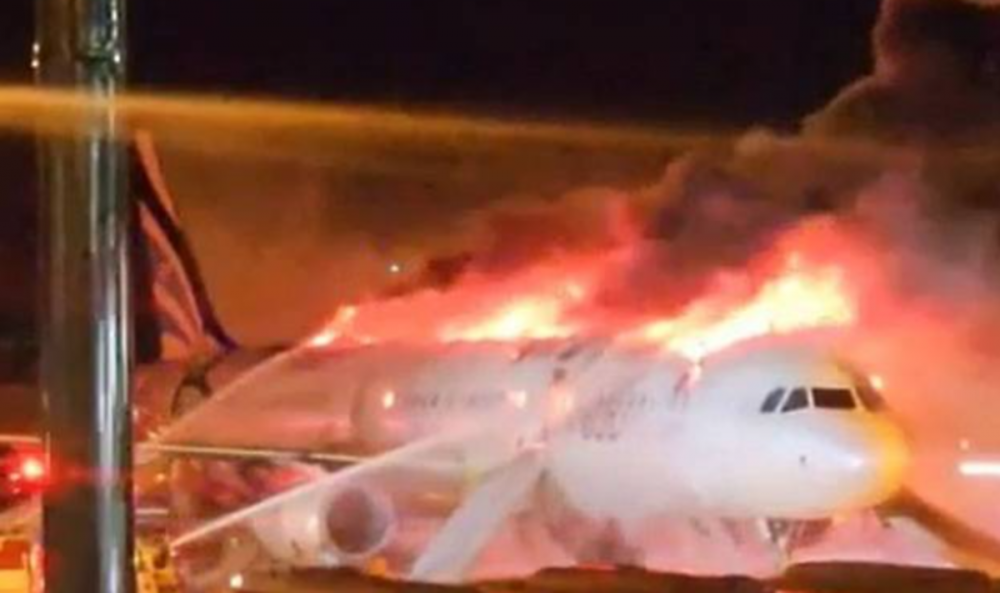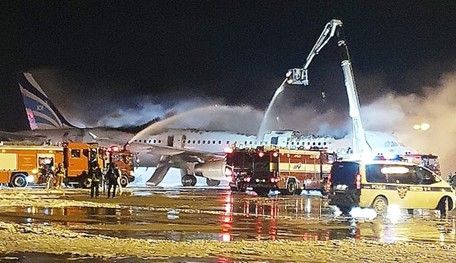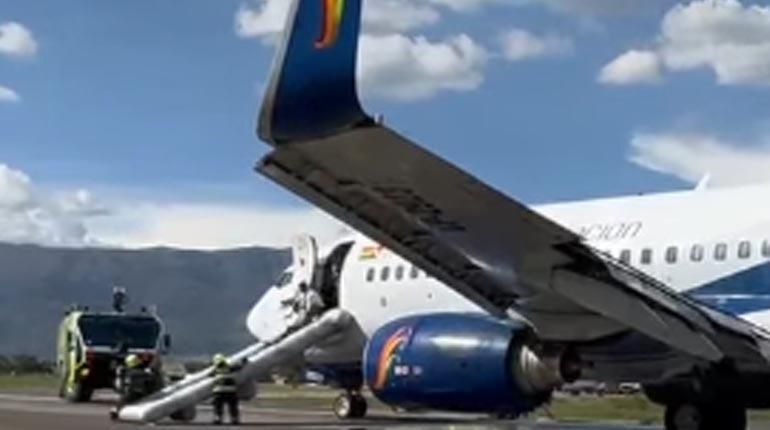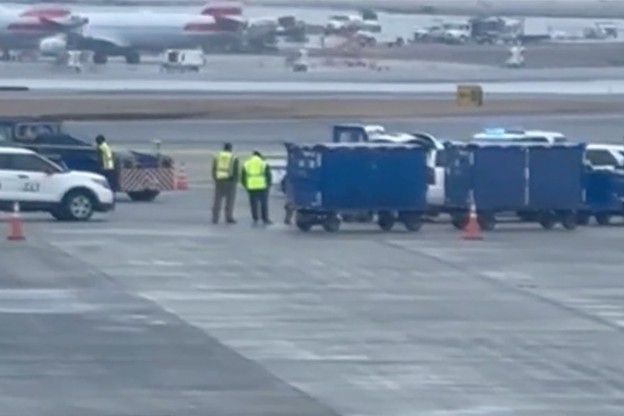ARFF Daily News
Published on:
Tuesday the 28th of January, 2025
These are the stories for today...
Of note, 176 safely evacuated from a burning A-321 at Busan-Gimhae (Pusan) International Airport in South Korea as well as another tragic reminder of the dangers of working on an airport ramp after an American Airlines employee was fatally struck by an airport ramp vehicle at CLT.
Be safe out there!
Tom
Fire erupts on AIR BUSAN flight at Gimhae, 176 passengers safely evacuated
Passengers escape unharmed from AIR BUSAN incident as flames engulf tail section.
At around 10:26 p.m. on the 28th, a fire broke out in the tail of AIR BUSAN flight BX391, which was preparing for takeoff from Gimhae International Airport.
The fire reportedly caused 176 people, including 169 passengers, 6 crew members, and 1 onboard mechanic, to evacuate using slides without any casualties. Two individuals sustained minor injuries during the evacuation process, but they are not life-threatening. The aircraft that caught fire is an Airbus A321, and the cause of the fire has not yet been determined.
Fire authorities received a report of the fire at the rear top of the accident aircraft at around 10:26 p.m. and dispatched a suppression team from the airport, which arrived at the scene by 10:34 p.m., eight minutes later, to suppress the fire.
However, as black smoke billowed from the fire and flames quickly spread to the front, fire authorities declared stage 1 response at around 10:38 p.m., four minutes after their arrival, calling in nearby firefighting resources for assistance. Stage 1 response is a warning order that mobilizes all personnel from the jurisdiction's fire station. The large fire was contained by around 11:24 p.m., and it was fully extinguished by approximately 11:31 p.m. However, the aircraft's fuselage was reported to have been completely consumed by the flames.
A fire official noted, "At present, it is presumed that the fire started inside the cabin, and it is estimated that all 176 people have evacuated; however, they are conducting a cabin search as a precaution."
https://biz.chosun.com/en/en-society/2025/01/28/57D2RX4VOBGQNNJSOVVMYORIMY/?outputType=amp


BoA reports that the aircraft suffered a "takeoff abort" and that it followed safety protocols
The Digital Times
The Bolivian Aviation Company (BoA) reported this Monday that flight OB648 Cochabamba - Santa Cruz operated by aircraft CP 2923, suffered a "takeoff abort" and that it followed safety protocols.
According to the state-owned company, there were 137 passengers and 7 crew members on board.
"After assessing the situation and in coordination with the airport's fire department, the crew decided to evacuate the aircraft as a preventive measure to ensure the safety of all on board," the statement said.
According to reports on social media, one of the plane's engines caught fire, so the passengers were evacuated as a matter of urgency. The company neither confirmed nor denied this version.
"Passengers were relocated to the international lounge for evaluation and flight rescheduling," BoA said.
The express stated that the procedure was carried out following strict security protocols." and that "BoA reiterates its firm commitment to the safety and well-being of our passengers and crew."

American Airlines employee fatally struck by airport ramp vehicle
By Isabel Keane
An American Airlines worker was struck and killed by a moving airport ramp on the tarmac of Charlotte Douglas International Airport in North Carolina, according to reports.
The unidentified employee was working on the aircraft’s ramp when they were struck by a ramp vehicle around 9:30 a.m. Monday, ABC News reported.
The ramp, also called an apron, is “intended to accommodate aircraft for purposes of loading or unloading passengers or cargo, refueling, parking, or maintenance,” according to the Federal Aviation Administration.
Emergency and medical crews responded to the scene, where the worker was pronounced dead, Charlotte-Mecklenburg police officials told CNN.
The airport said it is “working closely with airline and first responder partners in the ongoing investigation and is providing support as needed.”
“Our deepest condolences go out to the employee’s family, friends and colleagues during this difficult time,” airport officials said in a statement.
American Airlines told The Post it is “focused on ensuring that all involved have the support they need during this difficult time.”
“We are devastated by the accident involving a team member at Charlotte International Airport (CLT). Our thoughts are prayers with the family and our local team members,” the airline said.
Charlotte Douglas International Airport and the FAA did not immediately return requests for comment.
https://nypost.com/2025/01/28/us-news/american-airlines-worker-fatally-struck-by-airport-ramp/


NTSB Final Report: Textron Aviation Inc 208B
Witnesses Observed The Airplane Break Up In Flight And Subsequently Spiral To The Ground
Location: Snohomish, Washington Accident Number: WPR23FA034
Date & Time: November 18, 2022, 10:19 Local Registration: N2069B
Aircraft: Textron Aviation Inc 208B Aircraft Damage: Substantial
Defining Event: Aircraft structural failure Injuries: 4 Fatal
Flight Conducted Under: Part 91: General aviation - Flight test
Analysis: The pilot and three other crew members were performing flight testing for a new Supplemental Type Certificate (STC) for the single-engine turboprop-powered airplane. After departure, the pilot performed several maneuvers from the test card, then configured the airplane with the flaps extended for an intentional accelerated stall in a 30° left bank with the engine torque set to 930 ft-lb.
Analysis of ADS-B data combined with a simulation matching the recorded trajectory of the accident maneuver revealed that, after the stall, the airplane rapidly rolled to the left, reaching a roll angle of 120° while the pitch angle decreased to 60° nose down. The airspeed rapidly increased, exceeding both the maximum flaps-extended speed (Vfe) and the airplane’s maximum operating speed (Vmo). Recorded engine data indicated that, after the stall, the engine torque increased. ADS-B data was lost at an altitude about 7,000 ft above ground level; the final track data indicated an approximate 8,700 ft/min rate of descent. Witnesses observed the airplane break up in flight and subsequently spiral to the ground. The wreckage was found in a rural field distributed over a distance of about 1,800 ft.
Analysis of the aerodynamic loads in an overspeed condition showed that the wing design stress limit loads would be exceeded at high speeds with full flaps. The simulation of the stall maneuver indicated that reducing engine power to idle after the nose dropped could have reduced the rate at which the airspeed and associated aerodynamic loads increased, and would have likely given the pilot more time to recover.
The airplane was equipped with an Electronic Stability and Protection (ESP) system, which was designed to deter attitude and airspeed exceedances during hand-flying and maintain stable flight by applying an opposite force to the direction of predetermined travel. It was designed to provide a light force that can be overcome by the pilot. To deactivate the ESP, the pilot needed to navigate to a specific page in the primary function display (PFD). Although the accident pilot was an experienced test pilot and qualified to operate the airplane, his experience with the accident airplane’s avionics system could not be determined. Videos of his previous flights in the airplane suggested that he was unfamiliar with the ESP system, as he did not deactivate it before the flight nor discuss the forces it was applying during the flight.
Onboard video recording from a test flight the day before the accident indicated that, while performing a turning stall at idle power and 30° of left bank with the wing flaps extended, the airplane rapidly entered a left roll to a maximum of 83° before the pilot recovered to a wingslevel attitude. After recovery, the pilot pitched the airplane’s nose down about 25° in order to “get some airspeed back,” during which the ESP activated the autopilot to effect recovery to a level attitude. The airplane continued to gain airspeed, exceeding the Vmo of 175 knots and reaching 183 knots indicated airspeed, before pilot arrested the airplane’s acceleration and disconnected the autopilot.
These two exceedances illustrated shortcomings in the test execution. First, although the 83° roll exceeded the allowable roll limit during this maneuver, the crew failed to identify this exceedance even though they discussed what angle had been reached and had a data acquisition system on board, which they could have consulted to determine the maximum roll angle reached during the maneuver. Correctly identifying the roll exceedance would have resulted in a “failed” test. In accordance with risk mitigation procedures for the test plan, the test buildup should have been stopped after roll limits were exceeded in order to determine the reasons for the exceedance and to implement corrective actions before proceeding with higher-risk conditions in the test plan. Secondly, after exceeding Vmo, the crew did not remark upon the exceedance, and even though the exceedance met the requirements for an overspeed inspection as described in the airplane’s maintenance manual, there was no indication that this inspection was completed.
The accident flight simulation indicated that, during the stall immediately preceding the accident, it is likely that the ESP activated as the airplane pitched in excess of 19° nose-up. This would have required the pilot to apply more aft force on the control column in order to induce the stall. After the stall, the ESP would have activated at 45° bank, then deactivated as the airplane quickly exceeded 75°. The extent to which the control forces from the ESP, or the potential distraction due to the system’s engagement and disengagement, may have contributed to the pilot’s failure to recover from the nose-low attitude following the stall could not be determined.
FAA guidance warns of the risks associated with upset events during stall maneuvers and advises against performing accelerated stalls with flaps deployed due to the increased risk of exceeding the airplane’s limitations in this configuration. Following a nose-low departure from controlled flight, reducing the power to idle immediately is crucial to avoid exceeding airspeed limitations and overstressing the airplane.
The circumstances of the accident flight are consistent with the pilot’s improper recovery from a nose-low attitude following an intentional aerodynamic stall. Whether the increase in torque following the stall was the result of intentional application of power by the pilot could not be determined; however, the pilot’s failure to reduce engine power to idle following the airplane’s departure from controlled flight was contrary to published guidance as well as test flight hazard mitigation procedures. It is likely that this resulted in the airplane’s rapid exceedance of its airspeed limitations, and subsequently, a structural failure and inflight breakup.
Probable Cause and Findings: The National Transportation Safety Board determines the probable cause(s) of this accident to be -- The pilot’s improper recovery following a departure from controlled flight after an intentional aerodynamic stall, which resulted in an exceedance of airspeed limitations, airframe
overstress, and a subsequent inflight breakup.
FMI: www.ntsb.gov

Today in History
23 Years ago today: On 28 January 2002 TAME Ecuador flight 120, a Boeing 727, impacted a mountainside while on approach to Tulcán Airport, Colombia, killing all 94 occupants.
Date: Monday 28 January 2002
Time: 10:24
Type: Boeing 727-134
Owner/operator: TAME Ecuador
Registration: HC-BLF
MSN: 19692/498
Year of manufacture: 1967
Total airframe hrs: 64001 hours
Cycles: 49819 flights
Engine model: P&W JT8D-9A
Fatalities: Fatalities: 94 / Occupants: 94
Other fatalities: 0
Aircraft damage: Destroyed, written off
Category: Accident
Location: 27 km NW of Ipiales - Colombia
Phase: Approach
Nature: Passenger - Scheduled
Departure airport: Quito-Mariscal Sucre Airport (UIO/SEQU)
Destination airport: Tulcán Airport (TUA/SETU)
Investigating agency: Aerocivil
Confidence Rating: Accident investigation report completed and information captured
Narrative:
TAME Ecuador flight 120, a Boeing 727, impacted a mountainside while on approach to Tulcán Airport, Colombia, killing all 94 occupants.
TAME Flight 120 was a scheduled flight from Quito to Cali, Colombia via Tulcán. The Boeing 727 took off from runway 17 at 10:03 for the first leg to Tulcán. The flight climbed to the cruising altitude of FL180 and proceeded on the G-675 airway towards Ipiales from where it was to turn to Tulcán. At 10:15 the flight contacted Tulcán Tower. At that moment the airplane was 29 miles from the Tulcán NDB. The crew received permission to descend to FL140 and was given the current weather information, which included 8000 metres visibility, few clouds at 200 metres and overcast at 500 metres. The approach procedure called for a speed of 180 kts, but the actual speed was much higher at 230 knots. During the descent the airplane flew into the side of the Nevado el Cumbal Volcano at 14,700 feet, 1400 feet below the summit.
PROBABLE CAUSE (translated from Spanish):
1) The decision of the instructor captain and his crew to initiate and continue the operation towards Tulcan airport below the meteorological minima established in the company's SOPs.
2) Inadequate navigation and operation of the aircraft by the pilot flying and directed by the instructor captain, consisting of entering the holding pattern of the Tulcan radio beacon with a speed of 230 knots indicated airspeed and with a banking of 15 degrees exceeding the maximum stipulated speed limit of 180 knots during the entire procedure including the holding pattern and using a banking below the recommended range of 25 to 30 degrees, thus exceeding the lateral navigation and obstacle protection limits of the holding pattern, leading this operation to the collision with El Cumbal Hill.

Mailing Address
Subscribe to our newsletter
Contact Us
We will get back to you as soon as possible.
Please try again later.
